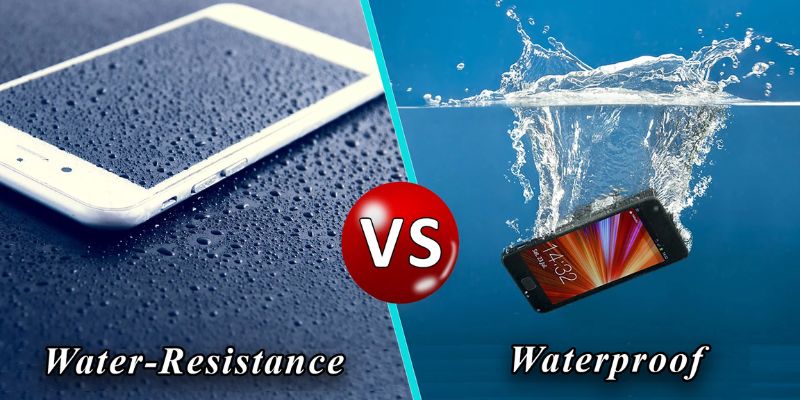Water resistance and waterproofing are terms commonly associated with products and materials that offer protection against water. However, there are notable differences between these two terms that are important to understand. In this article, we will delve into “What Are the Differences Between Water-resistant and Waterproof?”, exploring their definitions, features, and practical implications. By the end, you will have a clearer understanding of which option suits your needs best.
What Are the Differences Between Water-resistant and Waterproof?
Understanding Water Resistance
Definition and Explanation
Water resistance refers to the ability of a product or material to resist the penetration of water to some degree. It implies that the item can withstand exposure to water or moisture for a limited time or under specific conditions without becoming damaged or compromised.
Water Resistance Ratings and Standards
To provide consumers with a reliable measure of water resistance, various ratings and standards have been established. These ratings often appear as numbers on the product packaging, indicating the depth of water pressure the item can withstand. For example, a watch with a water resistance rating of 50 meters means it can endure water pressure equivalent to being submerged 50 meters deep.
Common Water-Resistant Materials and Treatments
Manufacturers employ different materials and treatments to enhance water resistance. Some common methods include the application of water-repellent coatings, sealing seams, using water-resistant fabrics, and employing gaskets or seals to create barriers against water intrusion.
The Concept of Waterproofing
Defining Waterproofing
Waterproofing takes water resistance to a higher level by ensuring complete protection against the ingress of water. A product or material labeled as waterproof can be submerged or exposed to water for extended periods without any water permeating through.
Waterproofing Technologies and Methods
Various technologies and methods are employed to achieve waterproofing. These may include the use of specialized membranes, sealing techniques, and advanced fabric constructions that prevent water molecules from passing through.
Popular Waterproof Products
Waterproofing finds extensive use in various industries. Some common waterproof products include outdoor gear like rain jackets and tents, electronic devices like smartphones and cameras, and building materials such as roof membranes and sealants.
Comparing Water-Resistant and Waterproof
Different Levels of Protection
The key difference between water resistance and waterproofing lies in the level of protection offered. Water-resistant products provide varying degrees of protection against water, but they are not entirely impervious to it. On the other hand, waterproof products offer an extremely high level of water protection, often ensuring no water ingress whatsoever.
Intended Use and Environments
The choice between water resistance and waterproofing depends on the intended use and the environment in which the product will be used. For activities that involve brief exposure to water or light rain, water-resistant items may suffice. However, for activities like swimming, heavy rain, or prolonged water immersion, waterproof products are the better choice.
Limitations and Considerations
It is essential to consider the limitations of both water-resistant and waterproof products. Over time, water resistance may deteriorate due to wear and tear, compromising the item’s protective capabilities. Waterproofing, while highly effective, can sometimes compromise breathability and result in a less comfortable user experience. It is important to find the right balance between protection and functionality based on your specific needs.
Choosing the Right Protection
Assessing Your Needs
To choose between water resistance and waterproofing, it is crucial to assess your specific needs and use cases. Consider the activities you will engage in, the environments you will encounter, and the level of water exposure you anticipate.
Deciding Between Water Resistance and Waterproof
Once you have assessed your needs, make an informed decision based on the level of water protection required. Opt for water resistance when light protection is sufficient, but choose waterproofing for more demanding situations where complete water resistance is essential.
Conclusion
In summary, water resistance and waterproofing are distinct terms with significant differences. Water-resistant products offer varying levels of water protection, while waterproof products provide complete water resistance. Choosing the right option depends on your specific needs, activities, and anticipated water exposure. By understanding these differences, you can make informed decisions when selecting products that suit your requirements.
Frequently Asked Questions (FAQs)
Are water-resistant and waterproof the same thing?
No, there are notable differences between water-resistant and waterproof, primarily in the level of water protection provided.
Can water-resistant products be used for swimming?
Water-resistant products may withstand brief water exposure or light rain but may not be suitable for swimming or prolonged water immersion.
Do waterproof products require any maintenance?
While waterproof products offer excellent water protection, it is still advisable to follow any maintenance instructions provided by the manufacturer to ensure their longevity.
Can water resistance or waterproofing be added to existing products?
In some cases, additional water resistance or waterproofing treatments can be applied to certain materials or products. However, the effectiveness may vary, and it is best to consult with professionals in such cases.
How long does water resistance or waterproofing last?
The durability of water resistance or waterproofing depends on various factors such as the quality of the product, frequency of use, and maintenance. It is important to check the manufacturer’s guidelines and inspect the item periodically to ensure its protective capabilities are maintained.

